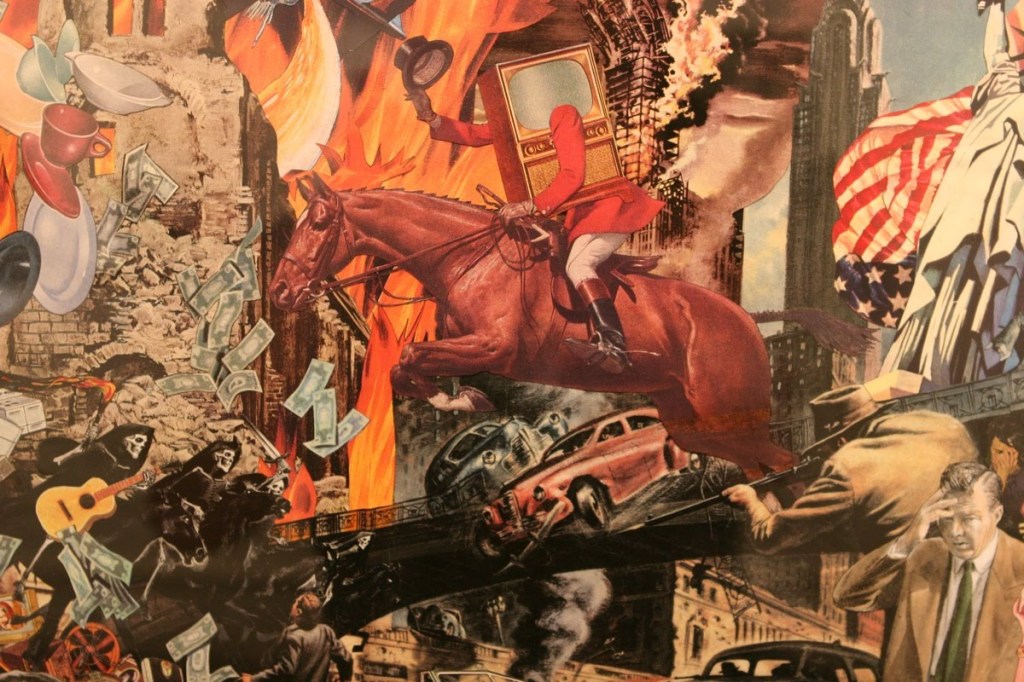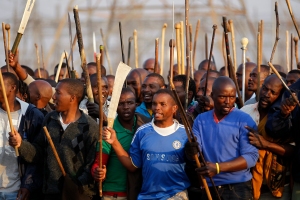Punk art surrealist Winston Smith, who named himself after the indelible protagonist of Orwell’s 1984, was once quoted (referring to a popular idiom), “You could say that artists are the canaries in the mineshaft. We see things before others do. We set off alarms and alert those who are distracted by other things. It’s not that we’re more sensitive or more aware…it’s just our job.” This is an allusion to the age-old practice of mining workers carrying caged canaries down into the tunnels with them. If dangerous gases such as methane or carbon monoxide leaked into the mine-shaft, the gases killed the canary before killing the miners.

Winston Smith Collage
Exemplifying Smith’s assertion of artist-as-indicator-species, this week Yoko Ono launched Artists Against Fracking, with a focus on New York hydraulic fracturing. Yesterday, just days after premiering his new video “We Want Peace — Reloaded,” former child soldier, peace activist, and hip-hop artist Emmanuel Jal was reportedly beat unconscious by South Sudanese police. Currently on exhibition in London, Art of Change: New Directions from China reveals how the best contemporary art moves beyond the particular to comment on universal experience. The current imprisonment of Russian feminist punk band Pussy Riot has sparked outrage and protests in solidarity worldwide.
Real miners endure a more wretched fate than the metaphorical ones referenced here, meeting with shattered health, physical brutality, and even murder for corporate profit, which ultimately are also recognized as an assault to the natural world as well.

Striking miners chant slogans outside a South African mine in Rustenburg
Approximately 36,000 workers are on strike at the Marikana platinum mine in South Africa’s North West province. Tensions have been high at the mine since 34 of the protesting workers were shot and killed by police last month, some of whom may have been shot while trying to surrender. This conflict has been one of the bloodiest rebellions in modern history.

Bandh in India shuts down Sesa Goa
All 90 iron ore mines in the western Indian state of Goa have been shut down after a government-backed inquiry said they were illegal and lacked environmental permission to operate. The shutdown is due in part to massive protests and a worker’s general strike covered on the Earth First! Newswire on August 27th. Villagers and environmentalists have long protested against the serious ecological damage done to the state’s rivers and forests by illegal mining.

Yanomami Gold Mining
In Venezuela last month, an attack by a group of illegal Brazilian gold miners on a group of Yanomami tribespeople left up to 80 people dead. The attack took place over access to the gold-rich land where communities of Yanomami people live. The location of the massacre – near the border with Brazil – was in an area so remote it took those who discovered the bodies days to walk to the nearest settlement to report the incident.
This week, hundreds of protesters battled riot police over plans for a gold mine in northern Greece’s Halkidiki peninsula. There have been similar miner strike and violent eco-collapse stories from the past several months worldwide, including Zambia, Peru, Brazil, Zimbabwe, Congo, and many others too numerous to list. And let us of course not omit the ongoing resistance to hydrofracking and strip mining all around the United States.
Look no further than Calle 13 to epitomize the role of artist as activist: [youtube=http://www.youtube.com/watch?v=DkFJE8ZdeG8]
“So, what about the canaries themselves?” you may be pondering…
While nearly all species of canaries are threatened, the Red Siskin Canary is critically endangered and faces imminent extinction.
~ story and news compiled by Molly J, Earth First! Journal collective

